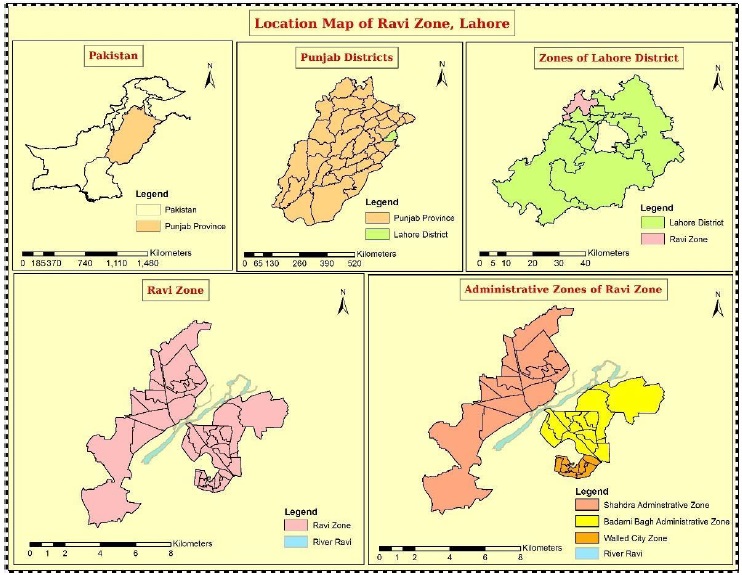Estimation of Multidimensional Urban Poverty in South Asian Cities: A Case of Lahore Metropolitan Area
DOI:
https://doi.org/10.33411/ijist/2020020404Keywords:
Multidimensional poverty, Metropolitan, Alkire & Foster approach, poverty cut off point, poverty indicesAbstract
Continuous monitoring of spatial variations in urban poverty is a complex multidimensional phenomenon. In urban areas of South Asian countries, various factors contribute to promote urban poverty e.g., rapid and unmanaged urbanization, high migration and inflation rates and fluctuations in land values. The poor community should be focused by policy makers to solve poverty related issues. This research was conducted in a metropolitan city Lahore in Punjab province of Pakistan which is confronting with urban poverty and need to construct a policy for poverty alleviation. Alkire-Foster approach was used to compute urban poverty by selecting poverty cut off point k=2/5 for this study. It demonstrates that 70.8% of households were poor whereas 29.8% households were living out of poverty with positive potentials. The results can be taken as a reference point to alleviate poverty in other regions of country.
References
World Bank. (2000). World development report 2000-2001: attacking poverty. World Bank Group.
Haughton, J., & Khandker, S. R. (2009). Handbook on Poverty and Inequality: Washington. DC: The World Bank.
Bhuiya, A., Mahmood, S. S., Rana, A. M., Wahed, T., Ahmed, S. M., & Chowdhury, A. M. R. (2007). A multidimensional approach to measure poverty in rural Bangladesh. Journal of health, population, and nutrition, 25(2), 134.
Khan, A. U., Saboor, A., Ali, I., Malik, W. S.,& Mahmood, K. (2016). Urbanization of multidimensional poverty: empirical evidences from Pakistan. Quality & quantity, 50(1), 439-469.
UN-HABITAT (2016). World Cities Report 2016: Urbanization and Development-Emerging Futures, UN, New York, Retrieved from: http://doi.org/10.18356/d201a997-en.
Elhadary, Y. A. E., & Samat, N. (2012). Political economy and urban poverty in the developing countries: Lessons learned from Sudan and Malaysia. Journal of geography and Geology, 4(1), 212.
Arimah, B. C. (2010). The face of urban poverty: Explaining the prevalence of slums in developing countries (No. 2010/30). WIDER working paper.
Mercado, S., Havemann, K., Sami, M., & Ueda, H. (2007). Urban poverty: an urgent public health issue. Journal of Urban Health, 84(1), 7.
Seals, A., & Nunley, J. (2007). The effects of inflation and demographic change on property crime: A structural time series approach. Department of Economicsand Finance Working Paper Series. Middle Tennessee State University, Murfreesboro, TN.
Gillani, S. Y. M., Rehman, H. U., & Gill, A. R. (2009). Unemployment, poverty, inflation and crime nexus: Cointegration and causality analysis of Pakistan. Pakistan Economic and Social Review, 79-98.
Hassan, M. S.,Akbar, M. S.,Wajid, A.,& Arshed, N.(2016). Poverty,urbanizationand crime: Are they related in Pakistan. International Journal of Economics and Empirical Research, 4(9), 483-492.
Vijaya, R. M., Lahoti, R., & Swaminathan, H. (2014). Moving from the household to the individual: Multidimensional poverty analysis. World Development, 59, 70-81.
Dehury, B.,& Mohanty, S. K. (2015). Regional estimates of multidimensional poverty in India. Economics: The Open-Access, Open-Assessment E-Journal, 9(2015-36), 1-35.
Mahoozi, H. (2015). Gender and spatial disparity of multidimensional poverty in Iran.
Gebreslassie, G. H. (2015). Multidimensional measurements of poverty analysis in urban areas of Afar Regional State. International Journal of Science and Research, 4(7), 2627- 2635.
Gebreslassie, G. H. Comparison of Multidimensional Measurements of Poverty Analysis: Cross Sectional Data Evidence from Tigray.
Dotter, C., & Klasen, S. (2017). The Multidimensional Poverty Index: achievements, conceptual and empirical issues (No. 233). Courant Research Centre: Poverty, Equity and Growth- Discussion Papers.
Kumi-Boateng, B., Mireku-Gyimah, D., & Stemn, E. (2015). Where are the Poor? Mapping Out A GIS-Multidimensional Non-Monetary Poverty Index Approach for Ghana. Ghana Mining Journal, 15(2), 11-20.
Santos, M. E., & Villatoro, P. (2018). A multidimensional poverty index for Latin America. Review of Income and Wealth, 64(1), 52-82.
Ab-Rahim, R., & Mohammed, M. (2019). Multidimensional Poverty Index of Niger State, Nigeria. International Journal of Academic Research in Business and Social Sciences, 9(7).
Poverty, O., & Human Development Initiative. (2019). Global multidimensional poverty index 2019: illuminating inequalities.
Oxford Poverty and Human Development Initiative(2017). “Pakistan Country Briefing”, Multidimensional Poverty Index Data Bank. OPHI, University of Oxford. Retrievedfrom:https://www.undp.org/content/dam/pakistan/docs/MPI/Multidim ensional%20Poverty%20in%20Pakistan.
Idrees, M. (2017). Poverty in Pakistan: A Region-Specific Analysis. The Lahore Journal of Economics, 22(2), 139-163.
Khan, F. N., & Akram, S. (2018). Sensitivity of multidimensional poverty index in Pakistan. The Pakistan Journal of Social Issues, 9, 98-108.
Afzal, M., Rafique, S., & Hameed, F. (2015). Measurement of living standards deprivation in Punjab using AF method (periodical comparison approach). The Pakistan Development Review, 739-762.
Khan, A. U., Saboor, A., Hussain, A., Sadiq, S., & Mohsin, A. Q. (2014). Poverty assessment as a multidimensional socio-economic concept: the case of the Rawalpindi region in Pakistan. Asia Pacific Journal of Social Workand Development,24(4), 238-250.
Chaudhry, I. S., Malik, S.,& Imran, A. (2006). Urban poverty and governance: the case of Multan city. The Pakistan Development Review, 819-830.
Awan, M. S.,& Iqbal, N. (2010). Determinants of Urban Poverty: The Case of Medium Sized City in Pakistan. Working Papers & Research Reports, 2010.
Zahra, K.,& Zafar, T. (2015). Marginality and multidimensional poverty: A case study of Christian community of Lahore, Pakistan. Pakistan Journal of Commerce and Social Sciences (PJCSS), 9(2), 322-335.

Published
How to Cite
Issue
Section
License
Copyright (c) 2020 50Sea

This work is licensed under a Creative Commons Attribution 4.0 International License.




















